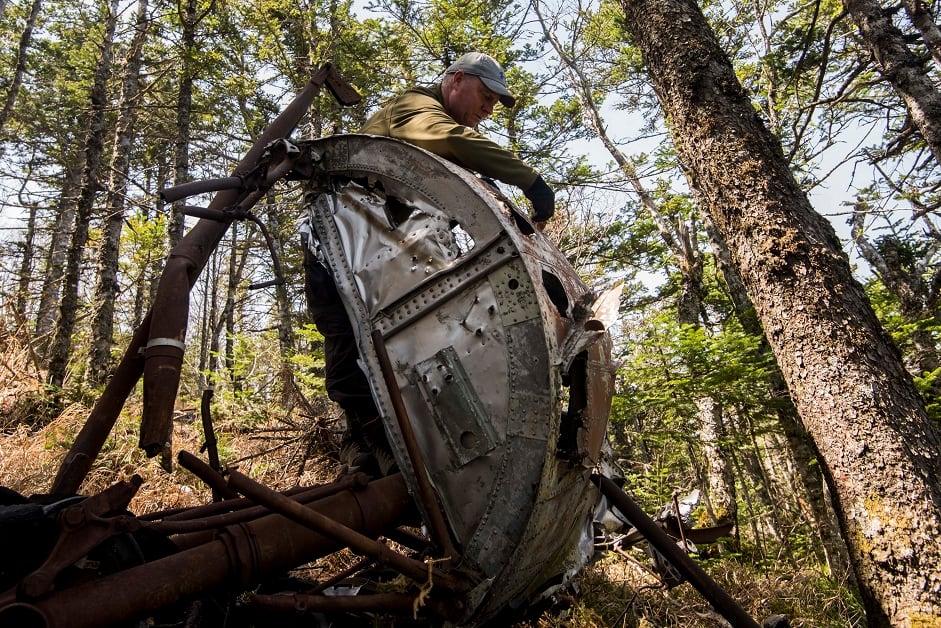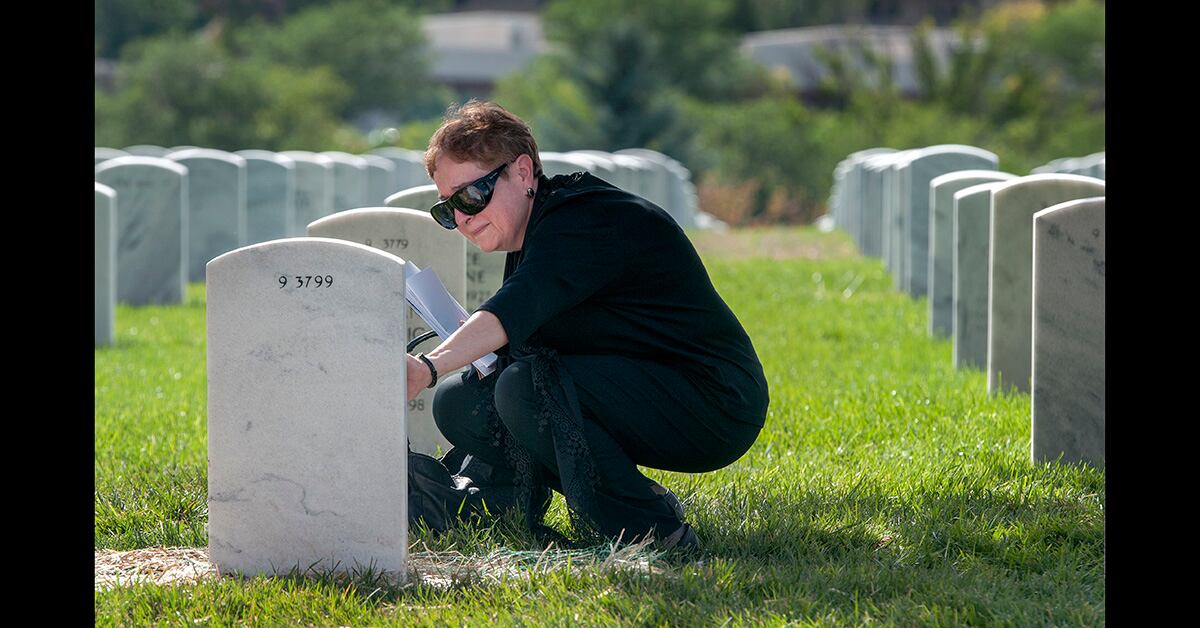ALBUQUERQUE, N.M. — Before his burial in Santa Fe late last month, Sgt. Alfonso Orlando Duran was one of nearly 73,000 American service members still missing in action from World War II.
But he never would have made it home without dozens of people over two continents working tirelessly over the course of more than a decade to find him.
Duran, an El Rito native, was 22 and serving as a substitute nose gunner with the Army Air Forces when his B-24 Liberator, nicknamed "Knock It Off," was shot down and crashed in what was then Yugoslavia on Feb. 25, 1944. He was the only member of the 10-person crew not to bail out, for unknown reasons.
RELATED

Fellow crew members reported at the time that Alfonso appeared uninjured, but would not leave the aircraft.
A tail gunner on a nearby aircraft said he saw "Knock It Off" assailed by "ack ack" — antiaircraft fire — and struck on its right wing, according to his eyewitness statement.
"It immediately passed out of sight below, and I did not see it again," he said.
"Knock It Off" was a part of the massive "Operation Argument," that targeted enemy aircraft factories and sought to destroy their forces in the air.
The 15th Air Forces, of which the sergeant was a part, lost 89 heavy bombers during the operation.
According to the U.S. Defense's POW/MIA Accounting Agency (DPAA), Duran's nine captured crewmates were interrogated by the Germans, who told them a body had been found at the crash site.
After the war ended in 1945, the U.S. spent six years actively recovering fallen American service members in the ravaged lands in which the war was waged.
"In 1951, the Department of Defense ceased active search and recovery operations from World War II," said Niall Brannigan, director of the DPAA's Europe detachment in Miesau, Germany. "The American public accepted that at the time because there was still a lot of faith in the American government."
But during those few years of searching, efforts to access areas of eastern Europe, including Yugoslavia, had already been hampered by the descent of the Iron Curtain. Animosity between Slovenia and the U.S. prevented most recovery efforts for decades, Brannigan said.
"Unfortunately, everything in places like Eastern Germany, Czech Republic and Poland, we just didn't have ready access to," he said. "So this case and other cases in Yugoslavia would have literally been put on the back burner."
Alfonso's mother, Maria Duran, would receive her son's belongings in a box after he was lost: letters, socks, a mirror, a billfold.
His fate would not be known for more than 70 years, leaving his mother, father and siblings behind to wonder what had become of their beloved son and brother.
Though Alfonso was gone, he was not forgotten.
Help from Slovenia
Amateur researchers around Europe have made a hobby of sorts of tracking down and identifying WWII remains.
Along with his staff of eight, Brannigan said, they are critical to the work the DPAA does in Europe, though he said it's impossible to respond to all the tips that pour in.
Slovenian citizens Raul Semenic and his wife, Renata Gutnik, spent more than a decade researching what became of "Double Trouble," a B-24 that trained with "Knock It Off" and crashed just minutes before on the same day.
Their research led them to surmise that a mass grave next to a centuries-old church in the town of Pokojisce had likely contained the remains of Alfonso Duran, though the headstone read that an unknown Australian airman was buried there along with four Slovenian partisans.
It never became clear why the villagers thought an Australian had been buried there.
While Gutnik and Semenic believed the body of Duran may have been buried there at some point, they were certain the U.S. had claimed the body and buried it elsewhere.
"I believe it was in 2015 or 2014 when we visited the 'Knock It Off' crash site and visited that grave at the church," Gutnik wrote in an email after Alfonso's burial. "But we were convinced that there were only bodies of local guys and that Duran was long ago sent home."
Until the two saw Alfonso’s name on the Tablets of the Missing, which contain the names of 1,409 MIA service members at the Florence American Cemetery in Italy.
So Gutnik reached out in April 2016 through a genealogy website to Pat Duran of Maryland, Alfonso Duran's niece, who had written briefly about her missing uncle on the website.
Pat Duran was in disbelief.
"My first thought was that this had to be some sort of scam," she said.

Duran, the daughter of Alfonso's brother, had grown up hearing a few stories about her uncle and witnessed her grandmother's sadness whenever they were told.
It wasn't a scam, and soon the two teamed up in the search for Alfonso.
Duran reached out to several military organizations, but became frustrated with red tape, lost paperwork and poor communication, eventually contacting then-Maryland Rep. Chris Van Hollen, who pressured the military to hasten its efforts.
In Slovenia, Gutnik contacted the U.S. Embassy and set about obtaining permission from various Slovenian parties to excavate the grave, including from the families of the others supposedly buried there.
"Our excavation would likely have been delayed until this year without (Gutnik's) tenacious sense of initiative," Brannigan said.
Brannigan also had to work to convince the Australian government that the body most likely was not one of their men, another time-consuming endeavor.
Congressional directive
The military first began researching the possibility that Alfonso's remains had been found in 2006 after being contacted by researchers.
Over the next several years, a team would return to the village of Pokojisce many times, interviewing researchers and residents of the tiny town.
That was before Congress directed in 2010 that remains of WWII missing again be actively searched for.
Before that, Brannigan said the agencies responsible for recoveries largely operated in a "reactive" manner.
The effort was also slowed by a few years, Brannigan said, when the Department of Defense combined the three separate agencies responsible for searching for the missing into one in 2015.
At last, in July 2017, they were ready to dig.
Through interviews and research, Brannigan and his team believed that Alfonso had originally been buried on the side of the church before being reburied in a mass grave at the back of the church in the 1960s where the headstone was located.
An elderly woman who had cared for the original grave for many years told the team she often had to recover the skeletal remains beside the church over the years.
Residents of Pokojisce believed Alfonso's remains had been placed in a box and placed atop the other four caskets of the partisans.
But when Brannigan's team started digging at the headstone, their shovels quickly hit solid rock just a few inches below the surface.
"Why this faux mass grave was put at the back of the church, I don't know," Brannigan said. "At the end of the day, it probably should have been classified as a memorial rather than a grave."
So the team turned to where they believed the original grave site to be on the side of the church.
There, they recovered human bones.
The skeletal remains were sent to the DPAA lab at Offutt Air Force Base, Nebraska, for testing for comparison with DNA collected from Alfonso's nephew, Stanley Evans of Santa Fe, as well as another nephew and a cousin.
On May 22, the DPAA announced that Sgt. Alfonso O. Duran had officially been accounted for.
And after more than 70 years, he was back in the country he fought for all those years ago.
News too late for some
While Duran said she and her family are grateful for the DPAA's work in bringing her long-lost cousin home, she wishes the family would have been informed of the work being done along the way.
Alfonso's brother and sister, for example, were still alive when the investigation began in 2006.
"Why didn't they reach out to the family to let them know, even if they weren't positive?" she said. "It would have meant the world to my father and my aunt to know more about it."
Alfonso was buried Aug. 22 in the Santa Fe National Cemetery. His living family members crowded into a small chapel around Duran's flag-draped coffin.
And at the military cemetery in Florence next to Alfonso's name, is a small, gold rosette at last.
“That made my heart sing,” Gutnik wrote. “A rosette is a mark that this man was found.”




